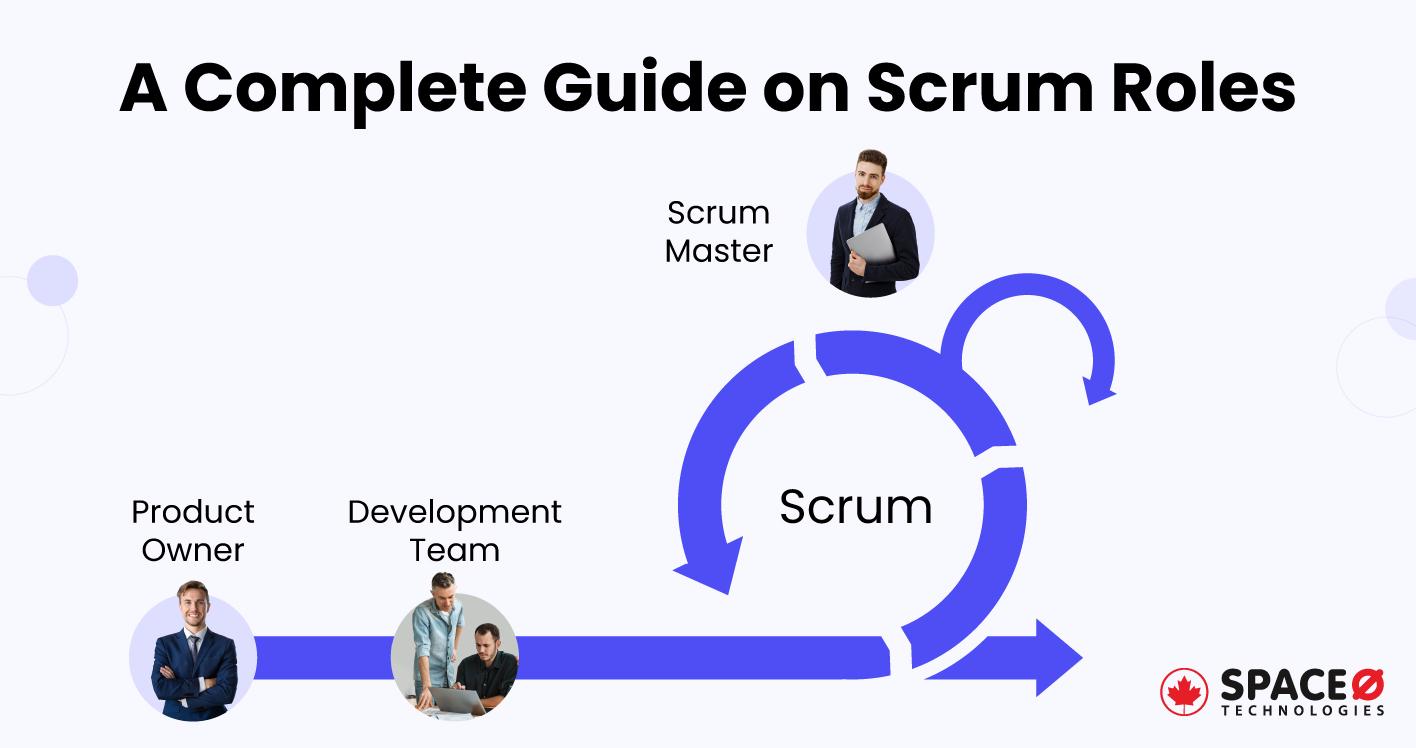
What are the Scrum Roles and Responsibilities? [Completely Explained]
Do you want to implement scrum methodology within your organization?
If yes, you must have read about the basics of the scrum method.
While studying the scrum method, there is one concept which you should know when you want to use Scrum either for your product development or business.
You might be wondering what that concept is – scrum roles.
As a trustworthy software development company in Canada, we have a proper understanding of the Scrum method and are aware of the Scrum roles and responsibilities. So, we have written this article to help you get clear about different roles in the scrum, the responsibilities of each scrum team member, and the challenges each scrum role faces.
Table of Contents
What are the Scrum Roles?
The scrum framework has three main roles; Product Owner, Scrum Master, and Development Team.
The core three roles in scrum are the backbone for the successful development of your project. With the contribution of each role, developing and managing each complex software project becomes easy.
Scrum is considered one of the agile frameworks. In agile software development, the scrum method offers certain rules, practices, and principles which ease the development of complex projects.
Moreover, we suggest you go through this complete guide on Scrum software development to gain a proper understanding of all Scrum roles.
Who is the Product Owner?
In agile software development, the product owner is a critical role that is responsible for driving the maximum value of the product and the work of the development team.
The product owner is the person who represents the concerns or expectations of all stakeholders to the scrum team. That means the product owner (PO) acts as an intermediary between the scrum team and all the stakeholders.
What are the Key Responsibilities of a Product Owner?
Here are the core responsibilities of a product owner in the scrum process.
- Developing and managing the product vision and strategy with both the scrum team and stakeholders.
- Creating and managing product backlogs and setting up prioritizing items based on their value to the project.
- Transforming complex requirements in user stories to make them easily understandable to team members for implementation.
- Regularly refining and re-prioritizing the product backlog to assure the team works on the tasks that are most valuable in delivering.
- Working with the Scrum team to bring clarity on the backlog items and feedback on development items.
- Reviewing the completed development sprints and assuring each sprint meets the defined acceptance criteria also aligns with the product visions and goals.
- Deciding when to release the different deliverables of the product.
Why is the Role of the Product Owner Important in Scrum?
Let’s know why you need a product owner for your project development.
- The product owner prioritizes the backlog to provide maximum value by focusing on the valuable tasks for higher ROI and customer value.
- The product owner is the core person who transfers product vision and creates product development strategy to the pre-defined expectations.
- The product is a centralized person that aligns the stakeholders and the scrum team towards shared understanding goals.
Who is a Scrum Master?
A scrum master is a core responsible person to guide and facilitates the implementation of Scrum principles and practices described in the scrum guide. As a scrum master, you act as a servant-leader to facilitate the scrum events like sprint planning, daily scrum (daily scrum meetings), sprint reviews, and retrospectives.
As a coach or mentor, a scrum master helps the scrum team, the product owner, and the organization to understand and implement the scrum framework effectively. The scrum masters help and guide individual team members of the scrum team in their roles and responsibilities as well as encourage self-organization and continuous improvement during the project development.
This role sets apart the scrum method from the rest of the different software development methodologies when developing complex projects. To gain a deep understanding of why scrum is popular and why scrum master is important, you should know the different software methods.
Want to Hire a Scrum Master for Your Project?
As a leading software development company, we have a team of experienced developers, designers, and the scrum master.

What are the Key Responsibilities of a Scrum Master?
Here are the core responsibilities of a scrum master within the scrum software method.
- Assisting in the smooth and impactful execution of scrum events like sprint planning, daily scrum, sprint reviews, and retrospectives, and even ensuring their effectiveness.
- Mentoring the scrum team, product owner, and organization on the scrum principles and practices implementation.
- Promoting self-organization and encouraging the team to make decisions collaboratively.
- Encouraging the whole team of the scrum for continuous improvement through sprint retrospectives to find areas of improvement in the product and producing a quality product.
- Monitoring and promoting the use of scrum artifacts and tools appropriately and effectively.
- Guiding and implementing the scrum processes to ensure the whole product development is transparent and open for improvement.
Why is the Role of Scrum Master Important in the Scrum Framework?
Learn about the importance of scrum master in project development.
- During development, if any conflicts occur among the scrum team members, the scrum master resolves and improves the overall process for effective product development.
- The scrum master ensures that every member of the scrum development team adheres to the principles, values, and practices of the scrum framework.
- The scrum master serves at three levels which are by facilitating and organizing events, making scrum teams self-organized and cross-functional, and helping to understand the implementation of scrum.
- Facilitates the regular reflection and adaptation of the past sprints to identify what works well and what work could be improved by providing actionable inputs.
Who are the Development Team Members in Scrum Framework?
The scrum teams consist of different professionals who help to deliver quality and powerful product development to the product owner or stakeholders. Generally, the scrum development team members’ roles are programmers, quality assurance, UI/UX designers, business analysts, and system architecture or technical lead.
Each of these scrum roles collaborates with each other and fulfills their individual responsibilities to deliver successful products to the client. They work closely and each of these roles in the development team is encouraged to be self-organizing for work, thus, providing the best results to the product owner.
What are the Key Responsibilities of the Development Team in Scrum?
Here are the core responsibilities of the development team when following a scrum.
- The development team is accountable to manage the product backlog which includes updating the backlog with new information, breaking down items into small and manageable tasks, and regularly updating the progress.
- The core responsibility of the development team is to provide high-quality and functional deliverables which align with the defined project requirements.
- Collaborate with the product owner and scrum master to understand the vision, goals, and product backlog items, and effectively implement the scrum process.
Why is the Role of the Development Team Important in the Scrum Process?
Let’s know the need or necessity of the development team when developing a project using the scrum process.
- The development team encompasses all the necessary skills and knowledge to develop incremental sprints for the entire product development.
- The development team plans, manages, and executes the work which is discussed and decided in the different sprints of the entire product development journey.
What are the Common Misunderstanding of the Scrum Roles?
Product Owner as a Project Manager
Treating the product owner’s role as a traditional project manager, rather than understanding their responsibility as a representative of stakeholders and the voice of the customer.
Scrum Master as a Team Lead
Confusing the scrum master role with that of a team lead or manager, instead of recognizing their role as a facilitator and coach who supports the team in adopting and implementing scrum practices as well as three pillars of it which are transparency, inspection, and adaptation. Learn about each pillar in detail from a blog on three pillars of the scrum.
Development Team Dependency
Need to understand the autonomy and self-organizing nature of the Development Team, resulting in a dependency on external direction or micromanagement.
Lack of Collaboration
Not recognizing the importance of close collaboration between the Product Owner, Scrum Master, and Development Team, leads to silos and decreased efficiency.
Neglecting Continuous Improvement
Overlooking the iterative and incremental nature of Scrum and neglecting the importance of continuous improvement through Sprint Retrospectives and adaptive adjustments.
Develop Scalable, Secure, and Fast Software Solutions
Hire our team of experienced developers, designers, consultants, and technical leads to thriving your digital business today.
If you are looking for more information about scrum roles, here is our FAQ section.
FAQ About the Scrum Roles
How Do the Scrum Roles Contribute to the Success of a Scrum Project?
These roles contribute to the success of a Scrum project in the following ways:
- The product owner ensures that the project delivers maximum value by prioritizing work and representing the customer’s needs.
- The scrum master facilitates effective collaboration, removes obstacles, and guides the team in adopting Scrum practices, enabling project efficiency and continuous improvement.
- Through their expertise and self-organization, the development team delivers high-quality increments that meet customer requirements and drive project success.
Collectively, these roles ensure customer satisfaction, efficient project execution, and the ability to adapt to changing needs, leading to successful outcomes in Scrum projects.
Who creates the definition of “Done”?
The entire scrum team collaborates to create the definition of work “Done”. They create a shared understanding of what means for work to be complete to maintain transparency in the entire process of the scrum.
How is the scrum master different from the product owner?
As you know both roles in the scrum are important, the scrum master focuses on the team and the development process and ensures the scrum values, principles, and practices are followed. Whereas, the product owner solely focuses on the product by deciding what features to develop and in what order based on the client’s requirement or business value.
Get Your Project Started With Scrum Agile Method
To truly harness the power of the scrum methodology, we must fully grasp the understanding of each scrum role.
- The product owner: A vision-driven strategist, channels stakeholders’ voices.
- The scrum master: A facilitator ensuring adherence to Scrum principles and their effective execution.
- The development team: The builders who translate visions into tangible, high-quality products.
Unlock the potential of the scrum; let these roles guide your journey to successful project management.
Are you looking to hire a scrum master for your project development or implement a scrum process within your organization? Let’s talk. We are one of the leading software development services providers in Canada, having experience in developing custom solutions for multiple industries like finance, logistics, management, and manufacturing.
Editor's Choice

Telemedicine Software Development: A Complete Guide to Building Remote Healthcare Platforms

Medical Billing Software Development: The Complete Guide for Healthcare Providers

A Complete Guide to Pharmacy Management Software Development
All our projects are secured by NDA
100% Secure. Zero Spam
*All your data will remain strictly confidential.
Trusted by


Bashar Anabtawi
Canada
“I was mostly happy with the high level of experience and professionalism of the various teams that worked on my project. Not only they clearly understood my exact technical requirements but even suggested better ways in doing them. The Communication tools that were used were excellent and easy. And finally and most importantly, the interaction, follow up and support from the top management was great. Space-O not delivered a high quality product but exceeded my expectations! I would definitely hire them again for future jobs!”

Canada Office
2 County Court Blvd., Suite 400,
Brampton, Ontario L6W 3W8
Phone: +1 (437) 488-7337
Email: sales@spaceo.ca

